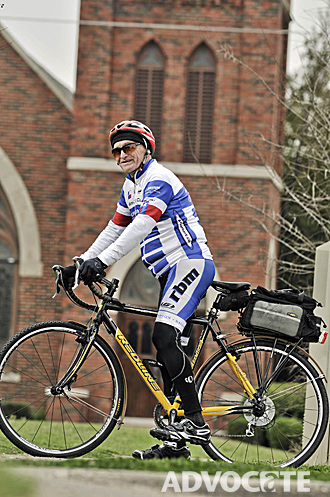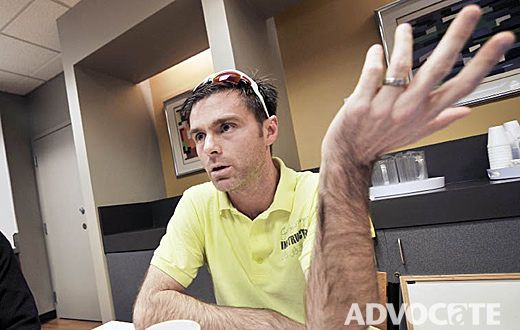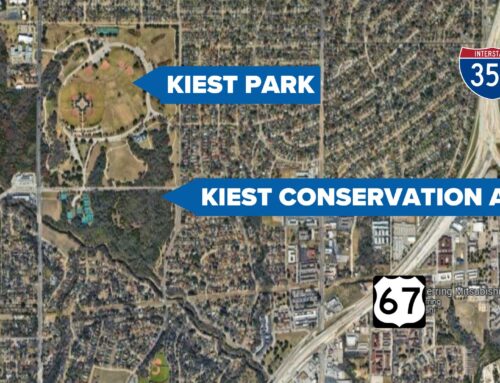Photos by Can Türkyilmaz
• View profiles of a variety of neighborhood cyclists with their rides.
• Catch up on our coverage of the Dallas Bike Plan.
• Scroll down this article for video, cycling rules and information on bike lessons.
A new saying in Oak Cliff goes that when people buy or rent places in our neighborhood for the first time, they are required to purchase a bicycle within the first 90 days of residency.
Everywhere you look in Oak Cliff, there’s two-wheeled transit. We’re the home of Bike Friendly Oak Cliff, the advocacy group that has spawned similar organizations in other Dallas neighborhoods. Thanks to BFOC and the many pedal pushers in our neighborhood, Oak Cliff is the bicyclingest place in all of Dallas.
But perhaps that isn’t saying much, since Dallas is considered one of the most dangerous places for cyclists. The editors of Bicycling Magazine in 2009 named Dallas the worst city in the Unites States for bicycling. They call us a sprawling, car-centric city with enormous arterial roads jammed with impatient hostile drivers in huge vehicles.
A recent comprehensive study by the Alliance for Biking and Walking ranked Dallas 49 out of 51 major cities for its percentage of residents who cycle to work. We rank 40 out of 51 when it comes to safety for cyclists, based on documented accidents and fatalities.
The same study, however, notes that Dallas’ plan to construct more than 1,000 bike-lane miles over the next 10 years is among the most ambitious in the nation.
[youtube]http://www.youtube.com/watch?v=fO4kNuT7-CM&context=C392a1eaADOEgsToPDskJiGlV0y0IH-b6xmzkOR31F[/youtube] [VIDEO: The city of Dallas recently approved the updated Dallas Bike Plan, which includes trail improvements and incorporating bike lanes into Dallas streets. It could take some time to see the changes because the city doesn’t have the millions needed to put the plan in place. But even without a bicycling infrastructure, cyclists and motorists can still coexist. Advocate photo editor Turk recently talked with local bike advocates and critics and gets both sides of the story.]One problem, though: The Dallas Bike Plan is not explicitly funded in the 2012-13 city budget, and it is expected to cost about $16 million to implement over 10 years.
The plan aims to improve driver and cyclist safety, advance public health and fitness, and clean up the air. It’s also about changing the culture of our city to one in which drivers don’t fantasize about running down cyclists for holding them up a few minutes on the road.
Oak Cliff cyclists are familiar with the hostilities of motorists. Take Dallas Torres, the 32-year-old bike builder who was injured on the Jefferson Viaduct in January. Torres suffered three broken vertebrae in his neck after a distracted driver hit him from behind. It was a terrible accident, but it wasn’t singular. Close calls and openly hostile drivers are common, Torres says.
“Cars get too close,” he says. “You don’t have to scare me. You’re in a car. You’re going to win every time.”
Torres says he wants to move out of Dallas to a more bikeable city. But others have hope for a bike-friendly Dallas.
City council member Delia Jasso says she became convinced our neighborhood could become bike and pedestrian friendly after the first Better Block project on Tyler Street in 2010.
“I was born and raised in Dallas, so I was not a bicycle rider,” Jasso says. “I was always very car-centric until the Better Block.”
The event, which created a bike lane on Tyler, along with other amenities such as sidewalk café seating and planters, showed her that those things could have a calming effect on traffic. Since then, she has backed bicycle infrastructure, and she now rides her bike more often in the neighborhood.

The Rev. Ernest McAfee rides from his home in Richardson to his church at 10th and Llewellyn in Oak Cliff as often as four times a week. The 73-year-old is also a bike racer.
“It seems like the city is taking it more seriously,” says Jason Roberts of Bike Friendly Oak Cliff, who is the mastermind behind Better Block.
“For so long, it was like, ‘Why are all these other cities building bike infrastructure, and we are losing? Why are we not leading the pack when all the cities around us are making progress?’ ”
The overall goal of the Dallas Bikeway System Master Plan, approved by the Dallas City Council last summer, is to create a comprehensive bike system, increase commuter and utilitarian bike trips across the city, raise awareness and education about bicycle safety, and eventually create complete streets, which make room for cars, bikes, pedestrians and public transportation.
Dallas currently has almost 400 miles of bike routes, mostly in the city’s center, but no bike lanes. The Dallas Bike plan aims to remedy that. It calls for increasing the number of shared-lane markings, bike lanes and paved shoulders to make the city more bike-able. The city has a good trail system that is improving, and the plan calls for continuing that work.
The bike plan is about more than just changing traffic patterns, says the city’s project coordinator, Max Kalhammer.
There’s the environment: “Part of the reason we got the funding to do the plan update is because North Texas Council of Governments had air quality funds available,” Kalhammer says. “Reduced emissions would have a positive impact on the region, not just the city.”
Then, there is public health: “Riding a bike to work every day as a transportation choice helps you stay in shape and be healthy and lead a healthy lifestyle, and most people who take active transportation to work are 70 percent less likely to have a heart attack because they’re [exercising] for 40 minutes a day,” he says.
Riding a bike is the most flexible way to commute without a car in Dallas, says Jonathan Braddick of Bike Friendly Oak Cliff. Braddick says he can get Downtown from his home in Kings Highway on a bike much faster than he can get there on a bus. Plus, buses don’t run frequently enough to be convenient, and for destinations other than Downtown, there are few cross-town routes.
There are times when Braddick can’t ride his bike, though. He travels to Austin for business about once a month, and while it would take only about 35 minutes to ride a bike from Oak Cliff to Love Field, there is no convenient route, and he would rather not haul his luggage on the bike. Love Field is only about nine miles from home, but by DART, it takes two buses, two trains and longer than two hours to get there.

Richard Wharton runs the Cycling Center of Dallas at the JCC and is a vocal critic of the Bike Plan.
“I’ve committed myself to this,” Braddick says of living without a car (although his wife has one). “It’s sometimes a lonely world out there.”
The Rev. Ernie McAfee rides his bike from his home in Richardson to his church, Christ Episcopal, on West 10th at Llewellyn.
The trip takes the 73-year-old about an hour and a half each way, and he says it gives him a good workout and time to think about his day.
A few times, he has been involved in serious accidents. Once, on the Jefferson Viaduct, a taxi sideswiped him, and he got away with a skinned elbow and some road rash. Another time, in Richardson, a car hit him from behind. His bike was wrecked, but he wasn’t injured.
Worse injuries have come, he says, from slipping on mud on trails, and once, when a dog ran out in front of him on a training ride. He wrecked doing about 25 miles per hour and broke his hip.
Overall, though, he says he feels safe riding a bike in Dallas.
“I think I’m safer that way than driving down North Central Expressway every day,” he says. “I’m certainly happier.”
A small group of self-styled “vehicular cyclists,” such as Richard Wharton, reject the whole idea of the bike plan, arguing it sets back the integration efforts of cyclists like him.
| Laying down a new infrastructure, Wharton says, would basically rewrite the rules of the road that have been established for more than a century — that bicycles are vehicles and should be treated as such via integration, not segregation.“I’m not against the Bike Plan. I’m against the placement of education at the bottom of the list. [Education is] cheap, it’s efficient and it’s quick.”Wharton says there’s something empowering about riding a bike on a busy thoroughfare during rush hour. You’re pumping along as two-ton vehicles approach from behind, slow down and pass. You own your lane. You’re confident, and you understand your rights as a cyclist. Wharton, owner of the Cycling Center of Dallas, demonstrates that bicycles can share the road harmoniously with cars — no bike lanes needed.Thrilling though it may be, most people won’t do it, says Zac Lytle of Bike Friendly Oak Cliff.“That’s fine if you’re a guy who wears spandex and can go 30 miles per hour down the road,” Lytle says.
He says it would be great if more people took vehicular cycling courses, but realistically, most people don’t want to. That’s too much like taking a defensive driving course, he says. Bike Friendly Oak Cliff works to teach cyclists safety and the rules of the road through group rides and other efforts. Kalhammer says the Dallas Bike Plan’s education component should come in the form of public service announcements and getting involved with children in schools. “Honestly, I think once the momentum of the bicycle culture starts, it’s going to happen organically,” he says. “Once people start seeing the bike lanes and how they operate, motorists will get used to it.” So what is happening with this bike plan, anyway? Even though the plan is not implicitly funded, most city leaders say the plan will be implemented along with routine street repairs. As crews repair roads, they will add bicycle infrastructure as they go. The Fort Worth Avenue Development Group recently raised $25,000 to create two miles of bike lanes on the avenue. The city also plans to create a two-way bike lane on the Jefferson Viaduct, plus lighting and a concrete barrier, that will cost $85,000. A funding source for this has not yet been found. Bike lanes are expensive, in part, because the city doesn’t own any equipment for striping lanes, so the trucks must be rented. But the city and county are working on an agreement to use Dallas County equipment for bike-lane striping. “We’re exploring ways to reduce those costs,” says city council member Scott Griggs, who lives in Stevens Park. Griggs says he would like to see bike infrastructure funding included in the city’s upcoming bond package proposal as well. Kalhammer is busy writing federal grant applications that would help pay for the bike plan. One would allow the city to hire a fundraiser for efforts to raise private funds for bike lanes, he says. Unfortunately, none of that will come soon enough for Dallas Torres. After a distracted driver doing at least 40 miles per hour crashed into him, Torres is shuffling around the house, watching TV and taking naps. It will take six months for his neck fractures to heal. He says he feels in his heart that the city will never take bike safety seriously, though they talk it up. “I’m not asking for 600 miles of bike lanes, like Portland,” Torres says. “But just signage would make a huge difference. It baffles me that we can’t come up with $100,000 to just put up signs saying ‘share the road.’ ” He also questions why the city doesn’t take a stronger stand against unsafe driving. There is no city ordinance banning texting while driving, for example. “How much does it cost to make that law?” he asks. FREE LESSONSRichardson Bike Mart offers free bicycling safety workshops. Visit bikemart.com. |
ROAD RULES• A bicycle is subject to the same traffic laws as cars. • Riding a bike on highways is illegal. • It is legal to ride on sidewalks, except for in Downtown, and cyclists must yield to pedestrians on sidewalks. • A cyclist must touch a foot to the ground at stop signs and can be ticketed for running red lights. • Helmets are required under a Dallas city ordinance. • Cyclists may ride “two abreast,” meaning two side-by-side. • Cyclists may take up as much of a lane as they feel they require. SAFETY• Always use hand signals to communicate with others on the road. • When riding in heavy traffic, it usually is safest to ride in the center of the lane so drivers won’t be tempted to pass you within your lane. • When riding at night, consider yourself invisible. Employ a rear light and a strong headlight when it’s dark out. Even with lights, motorists might not see you, so take extra precautions. • When possible, ride in groups. • Never ride against traffic. CYCLIST ETIQUETTE• Always follow the rules of the road. This makes you a good ambassador for cyclists. When motorists see cyclists breaking the rules or behaving dangerously, it makes them angry. • Try not to slow drivers down in situations where it can be avoided, for example: Wave cars through an intersection before you reach it. • When riding on trails, call out to pedestrians to warn them you’re passing. • Don’t race on the trails. Very fast riding is best kept to the streets. MOTORIST ETIQUETTE• Never bully a cyclist. In a fight, a car will win every time. Give cyclists space and be patient when they are ahead of you. • Lay off the cell phone. It is not illegal to text while driving, except in school zones, but it is extremely dangerous. Sources: Dallas city ordinances, cycling advocates |
RIDE LIKE THE PROS
Cycling Savvy DFW offers a three-part course at Northway Church, teaching the principles of riding in traffic. It begins with a classroom discussion followed by bicycle training in the parking lot. Finally, cyclists put their skills to the test on a tour of the city. The program started in Orlando, and the curriculum comes from the Florida Bicycle Association. Instructors Richard Wharton, Waco Moore and Eliot Landrum show Dallas students how to cycle safely on any road in Dallas without using sidewalks or hugging the right curb. “You lead the dance,” Wharton says. “A driver is a driver whether it’s on two wheels or four.” The next programs are March 2-3 and April 27-28. The cost is $75. For more information, visit the Dallas section of cyclingsavvy.org.






